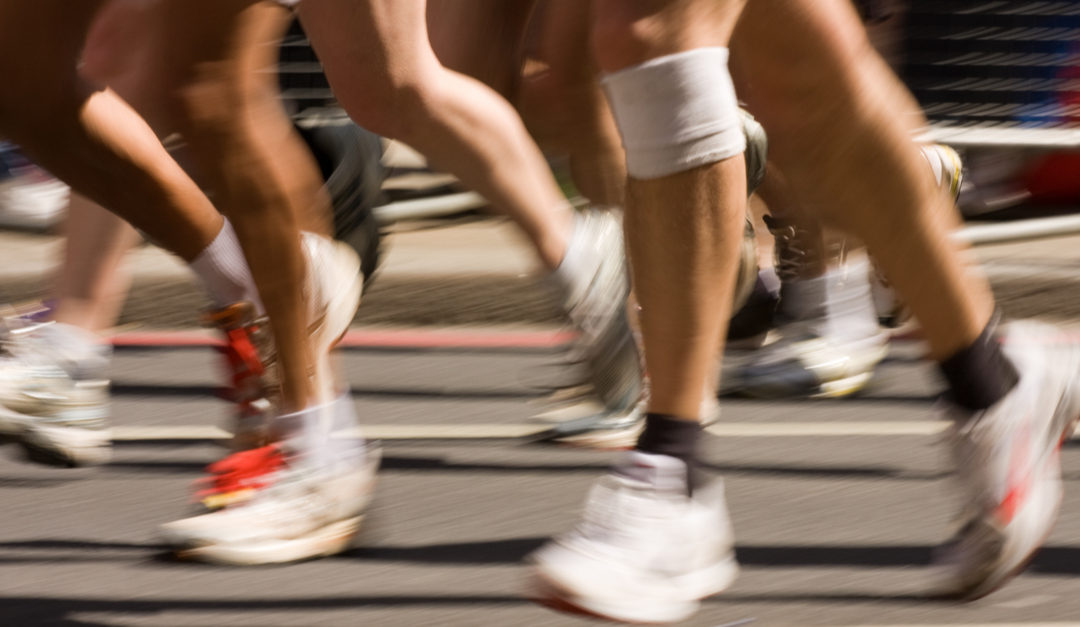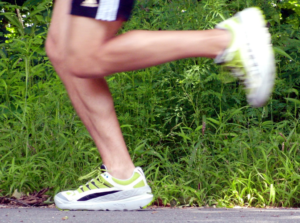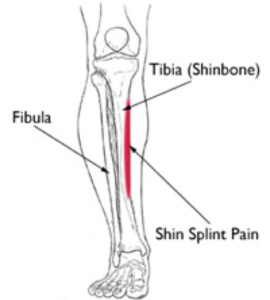The most important thing long distance runners can do to ensure they keep running is take care of their knees. But that’s easier said than done. Because of the constant foot to ground impact during long distance runs, most athletes will experience a knee injury at some point in their career. Here is all the information you need to know about the three most common:
Patellofemoral Pain Syndrome (Runner’s Knee)
Related anatomy. The knee joint is made up of three bones: the femur, tibia, and patella. These bones are connected to one another by strong soft tissues called ligaments and tendons, which connect muscles to bone. Runner’s knee is said to occur when the ligaments and/or tendons that attach to the patella, or even the cartilage behind the patella becomes irritated, aggravated, and/or inflamed.
Illustration 1- The front of the knee experiences a heavy load while running
Causes. There are two main causes of runner’s knee. The first, and most obvious, is overuse. The second is a patellar maltracking.
Symptoms and treatments. A dull, aching pain is associated with runner’s knee. This pain may temporarily limit or sideline athletes but is usually treatable. Conservative treatment options, such as rest, ice, and nonsteroidal anti-inflammatory medications in conjunction with physical therapy, bracing, and activity modification, will assist to decrease inflammation, improve strength, and help injured athletes recover.
Prevention. Once runner’s knee has been effectively treated, injury prevention measures should be taken. Athletes should avoid increasing the intensity or duration of their workouts too quickly, and wear a knee brace if necessary.
Meniscus Tears
Related anatomy. The meniscus sits between the femur and tibia and acts as a “shock absorber”—cushioning the bones during impact while walking and running.
Illustration 2- A torn meniscus
Causes. Meniscus tears are often caused by sudden pivoting, or twisting and turning movements while running.
Symptoms. The first presenting symptom is often a “pop” heard when the meniscus is torn. Other symptoms that can quickly follow are pain, stiffness, swelling, catching, and locking. Additionally, injured athletes often state that they feel their knee is going to “give out” or lock.
Treatments. Conservative treatment options, such as rest, ice, medications, and physical therapy, are always tried first. When they aren’t effective, an MRI is performed to confirm the diagnosis and if necessary surgical intervention in the form of arthroscopic microsurgery may be necessary. During a 1-2-hour procedure, an orthopedic surgeon locates the torn meniscus and then removes or repairs it based on location and severity.
Shin Splints
Related anatomy, causes, symptoms. There are thought to be several different causes of shin splints. In one case, the muscles that attach to the inner portion of the tibia are overused, they become inflamed and cause mild-severe pain in a condition known as shin splints. In another instance the covering of the bone, or the periosteum, may become inflamed causing diffuse pain over the length of the tibia. In yet another instance, actual stress fractures, or hairline cracks may develop in the bone, causing pain. If the exact diagnosis or cause is unclear, an MRI may often be helpful to establish a more accurate diagnosis.
Illustration 3- Shin splint pain is localized to the inner part of the tibia
Treatments. Treating mild to moderate shin splints is relatively easy—ice and anti-inflammatory medications, and activity modification may help injured athletes return back to their sport quickly Treating severe shin splints can be a bit more difficult. Often times, immobilization in a walking boot is necessary. Downtime can be anywhere between a few days to several weeks.
Seeking Treatment for Knee Injuries
If you’ve injured your knee and it’s limiting your running, please contact our offices in Mahwah or Clifton, NJ to arrange an appointment. After an accurate diagnosis has been made, a personal treatment plan will be prescribed. You can expect to be back running very soon when under our care.
Dr. Nicholas Alexander is the founder of Mahwah Valley Orthopedic Associates and a Board Certified Orthopedic Surgeon specializing in both the surgical and non-surgical treatment of hip and knee conditions. Dr. Alexander completed his Fellowship in Adult Reconstruction and Reconstructive Surgery of the Hip and Knee at the Johns Hopkins School of Medicine and has over two decades of experience. He also serves as the Chairman of the Valley Hospital Total Joint Center.




